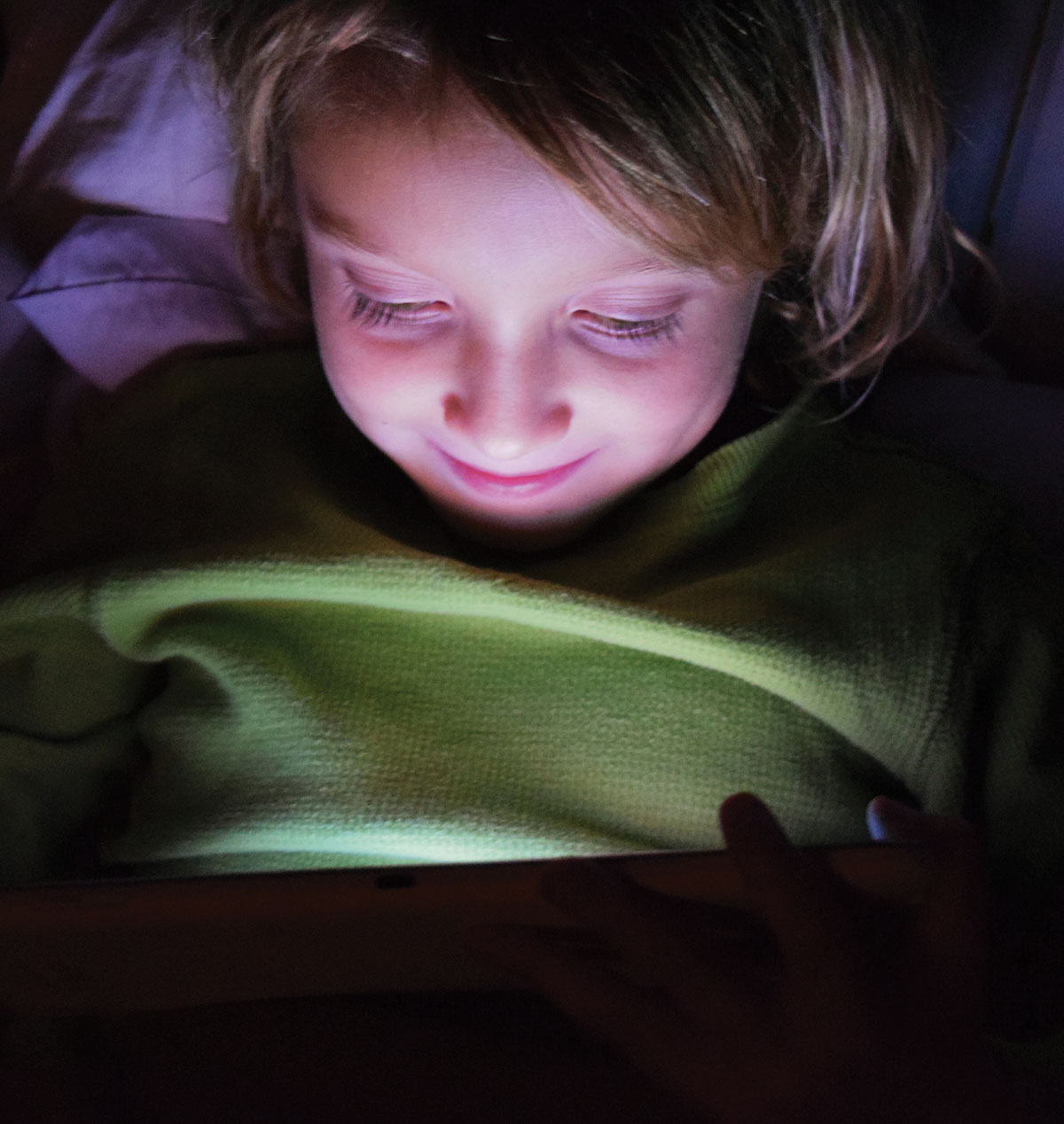
It’s become the norm for both adults and children to spend hours in front of a screen every single day. There are plenty of benefits to being plugged in: countless academic and professional resources at our fingertips, better ways to keep in touch with long-distance relatives, and the availability of apps that are both fun and educational. But the average 8- to 10-year-old spends nearly eight hours a day exposed to media (with five hours of direct media use), and older kids and teenagers spend about 11 hours a day exposed to media, according to a 2010 Kaiser Family Foundation study. Recent research is now showing that too much time on a device can cause a range of long-term issues, including attention problems, subpar academic performances, poor interpersonal skills and sleep disturbances.
Balance is obviously key to a healthy approach to screens. But teaching balance to children requires that parents lead by example, modeling healthy screen usage. That is a challenge for many adults, because we are also guilty of overusing our devices — and our own addiction is only getting worse. According to a recent eMarketer study, adults currently spend almost three hours each day on a mobile device engaging in recreational activities such as social media and perusing the Web. By 2016, experts project that our screen usage will increase by 14 minutes per day. And these numbers don’t even count time spent talking on the phone (if you actually do that anymore).
So, how do we model good screen behavior for our kids when work emails are pinging in at all hours of the day, Instagram is beckoning, and you just need to get that one important text out?
Setting limits
To combat unhealthy media usage and potential screen addiction, parents must set some ground rules, enforce them and then practice what they preach, experts say. Although screen addiction is not currently a clinical diagnosis, experts advise that parents seek professional help for their children if they observe that screen time is seriously interfering with schoolwork, sleep habits and in-person socialization.
Caroline Knorr, parenting editor at Common Sense Media, emphasizes that it’s important to set appropriate screen-time limits that work for your family — and then adhere to them. For example, don’t just leave the TV on in the background after your favorite show is over. It’s unnecessary to have a screen on when it’s not being used, and background TV has a negative correlation with language acquisition.
Regulating usage is critical, so it’s important that parents be clear with their children about how much screen time is acceptable.
“Kids generally have difficulty learning self-control, and this is the case with screens, too. So, I would really encourage families to have a weekly screen-time plan in place as you go into the week. Help your kid keep to the limits,” Knorr says.
Explain to your kids that technology and media should not be used during family time because it detracts from the experience of truly spending quality time together. Just like everything else that parents teach their kids, it’s crucial to hold yourself to the same standards. If children aren’t allowed to have devices at the dinner table, then parents’ phones should be put away as well.
When your child talks to you, put down your device and give them your complete attention — because that’s certainly what you’d expect from them.
“Most importantly, use your technology as tools, not treats,” Knorr says. “Show kids how the mapping program works and helps you find your way. Skype with Grandma as a way of helping kids bond with far-flung relatives. Activities that are utilitarian versus pure entertainment help show the value of devices as tools that enable our lives.”
If kids consistently see that their parents are only partially present, it’s completely understandable that they’ll mimic those behaviors. But when parents make a point of showing their children the importance of being authentically present, kids will be more likely to follow their example.
Modeling good behavior
Experts say it’s critical that parents model healthy media consumption the same way they lead by example when it comes to healthy eating and safe driving.
One of the biggest concerns about excessive screen use is that it detracts from fully engaging in real-life experiences. For example, we sometimes get so caught up in capturing that flawless photo of our social outing that we end up ignoring friends and family members as we search for the perfect Instagram filter.
Dimitri Christakis, M.D., director of the Center for Child Health, Behavior and Development at Seattle Children’s Hospital, has tracked the consequences of too much screen time and says it’s crucial that parents model the behavior of being fully present during a family activity.
“When you see parents at the park with their young children, they’re often on their phones as they push the swing with one hand. It’s great that they show up to their kids’ sports games, but they’re staring at their device rather than watching the game,” he says.
And kids notice. “A lot of studies are coming out now about kids saying that their parents spend too much time on their phones,” Knorr says. In fact, in a recent study, one-third of children in the Netherlands said their parents spend more time on their devices than they do actually interacting with them. More than half of the children in the study reported that their parents check their devices too often and, as a result, the children said they often feel ignored or unimportant. In Brazil, a whopping 87 percent of children said their parents spend too much time on their devices, and 56 percent of the children surveyed wished they could take away their parents’ devices altogether.
If kids consistently see that their parents are only partially present, it’s completely understandable that they’ll mimic those behaviors. But when parents make a point of showing their children the importance of being authentically present, kids will be more likely to follow their example. When they’re out with their own friends, they’ll recognize that it’s disrespectful to scroll through their phones rather than fully engaging and enjoying time together.
Knorr also says parents should not hand over their phone or iPad when a child is bored or fussy. Although it may be easier in the moment, she says, this practice prevents children from learning how to self-soothe and figure out creative ways to keep themselves busy.
For long car trips, bring books or activities that will keep your kids entertained and remind them that plenty of enjoyable, interesting activities exist outside their devices and apps.
Still, media is undeniably a part of all our lives. Parents can model positive behaviors by planning some family activities that incorporate healthy media usage.
“Set aside time for a media night for family — a movie night, a game night, an app duel. These are fun ways to enjoy media, and your kids will respect your rules more if you are engaged in media, too,” Knorr suggests.
Even when children are too young to have their own social media accounts, it’s not too early to instill key values. For example, it’s a good idea for a parent to ask their child’s permission before posting his or her pictures to Facebook, many experts agree. When they have their own page in a few years, they’ll know from example that it’s a healthy and respectful practice.
How much screen time is appropriate?
“Not all screen time is equal,” Knorr says. “There are plenty of games that actually have educational value for kids of all ages, from learning numbers and letters for little kids to coding for the older ones. Studies are emerging that show that interactive digital media has learning potential — especially when an engaged parent, teacher or caregiver is actively supporting the learning.”
She encourages parents to extend media into hands-on learning experiences. “Use it as a launch pad for discovery and exploration via museum trips, crafts, books and other activities.”
Even so, keep limits in mind. Christakis recommends that children of all ages spend no more than one hour per day on their devices.
The negative effects of too much
According to Knorr, screen addiction is an appropriate term when a child has reached a point where screen time seriously interferes with normal, healthy activities, such as homework, sleep and human interaction. If a child exhibits these signs of addiction, there are plenty of treatment options, and it’s time to get a doctor involved.
And while many behaviors don’t reach the level of full-blown addiction, they are still liable to negatively impact a child’s development and family life in the home.
Research performed by Christakis and his team at Seattle Children’s has shown that too much screen time at an early age is linked to attention problems later in life. Kids who excessively use social media and video games are more likely to develop weight problems and engage in dangerous behaviors, such as alcohol use.
Knorr points to studies that have shown some teens report depression related to social media. Additionally, dangerous behaviors like cyberbullying are typically the result of excessive screen exposure.
If a child doesn’t learn healthy screen habits at home, they are likely to continue misusing their devices for years to come — and that’s exactly why parental modeling is so important.
“We’ve found that about 10 percent of college-age kids have problematic or compulsive Internet usage,” Christakis says. “That makes it more common than any other chronic childhood illness, such as asthma and ADHD. It’s an emerging epidemic that parents should be aware of. It starts early, and the habits carry into adult life.”
Awareness is power, and it means parents can take steps to enforce reasonable rules and, more importantly, show their kids what healthy screen usage looks like. While unhealthy screen time is certainly a very real problem, parental modeling is the best way to ensure that children will use their devices in a healthy, respectful manner.









